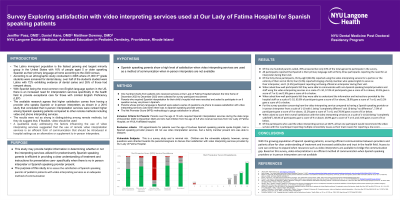Patient Management
478 - Survey Exploring Satisfaction with Video Interpreting Services Used at Our Lady of Fatima Hospital for Spanish Speaking Patients


Jeniffer Paez, DMD
Pediatric Dental Resident
NYU Langone Medical Center, Brooklyn, NY
NYU Langone Medical Center
East Providence, Rhode Island, United States- DK
Daniel J. Kane, DMD
Program Director
NYU Langone Dental Medicine, Brooklyn, NY
Brooklyn, New York, United States
Presenting Author(s)
Program Director(s)
Purpose: To assess the satisfaction of Spanish speaking parents of pediatric patients with video interpreting services as an adequate method of communication
Methods: One hundred charts were collected that reported a need for a Spanish interpreter were used for the survey. Spanish speaking parents of pediatric patients who underwent treatment at Our Lady of Fatima Hospital (OLFH) were contacted via phone and asked to participate in a voluntary 8 question survey. All communication was done in Spanish. The parents included in the study all spoke Spanish as their primary language.
Results: Of the one hundred parents called, 49% answered but only 43% of the total agreed to participate in the survey. All participants reported that Spanish is their primary language with all forty-three participants reporting the need for an interpreter during their visit. Of the forty-three participants, thirty-eight (88.4%) reported using the video interpreting service for a portion or the entirety of their visit at OLFH, four (9.3%) reported bringing a family member who spoke English to serve as their interpreter, and 1 (2.3%) participant reporting not being offered an interpreter during their visit. When asked how well participants felt they were able to communicate with non-Spanish speaking hospital providers and staff using the video interpreting services on a scale of 1-10, 57.9% of participants gave a score of 9 or above, 39.5% gave a score of 7 or 8, and 2.6% gave a score of 6 or below. When asked how well participants felt they were able to understand the information and instructions provided by the hospital staff on a scale of 1-10, 65.8% of participants gave a score of 9 or above, 28.9% gave a score of 7 or 8, and 5.3% gave a score of 6 or below. For the survey question concerning how the video interpreting service compared to having a Spanish speaking provider or in-person interpreter from a scale of 1-10 with 1 being "completely different" and 10 being "no difference", 7.9% of participants gave a score of 9 or above, 13.2% gave a score of 7 or 8, and 78.9% gave a score of 6 or below. When asked to score their overall satisfaction with the video interpreting services on a scale of 1-10 (10 being “completely satisfied”), 68.4% of participants gave a score of 9 or above, 28.9% gave a score of 7 or 8, and 2.6% gave a score of 6 or below. Of the participants who used the video interpreting services at OLFH, all but one participant would recommend the video service with the 1 participant reporting multiple connectivity issues as their main reason for giving a low score.
Conclusions: With the growing population of Spanish speaking patients, ensuring efficient communication between providers and patients allow for clear understanding of treatment and
increased satisfaction and trust in the health field. Access to care can continue to expand when resources such as video interpreters are available to bridge the communication gap. Based on this survey, video interpreters are an efficient method of communication when Spanish speaking providers or in person interpreters are not available.
Identify Supporting Agency and Grant Number:

.jpg)